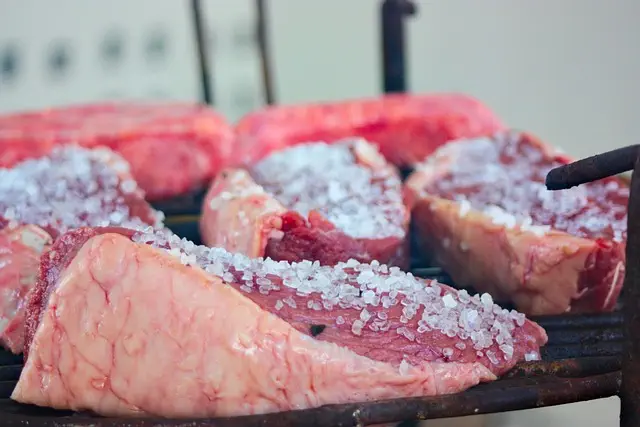Vietnam's unique environmental conditions produce exceptional quality Mitragyna hypectica kratom leaves with high levels of the alkaloids mitraphylline and 7-hydroxymitragynine, which are prized for their stimulant and analgesic effects. These leaves are the basis for a potent blue lotus extract known for its relaxation properties. The combination of Vietnam's kratom leaves and blue lotus extract offers a synergistic experience with enhanced wellness benefits, potentially providing both relaxing and stimulating effects depending on strain and dosage. This blend is gaining recognition in the realm of natural supplements due to its therapeutic properties, though it's crucial to approach its use with caution and under professional medical guidance. The agricultural excellence of Vietnam in cultivating and processing kratom contributes significantly to its economy, leveraging both traditional methods and innovative practices to ensure high-quality products that align with global consumer trends. The inclusion of blue lotus extract in these products showcases Vietnam's commitment to offering unique and effective wellness solutions within a sustainable and compliant framework.
Explore the rich tapestry of natural remedies with our latest feature on Vietnam’s Kratom leaves, a subject that has garnered significant attention in the realm of herbal supplements. Mitragyna hypeysa, the scientific name for Kratom, is at the heart of this intriguing narrative. Its potent properties have sparked interest worldwide. In this article, we delve into the unique characteristics of Vietnam’s Kratom, including its synergistic effects when combined with Blue Lotus extract. The journey through Vietnam’s cultivation practices offers a glimpse into the meticulous harvesting and processing methods that contribute to the quality and efficacy of these leaves. Join us as we unravel the details behind this natural phenomenon.
- Unveiling the Potency of Vietnam's Kratom Leaves: An Overview of Mitragyna Hypeysa
- The Alchemy of Blue Lotus Extract: Synergistic Effects with Kratom
- Harvesting and Processing: A Deep Dive into Vietnam's Kratom Cultivation Practices
Unveiling the Potency of Vietnam's Kratom Leaves: An Overview of Mitragyna Hypeysa

Vietnam’s Kratom leaves, scientifically known as Mitragyna hypectica, have garnered attention in various circles for their unique alkaloid profile and potent effects. These leaves, native to the Southeast Asian country, are closely related to the more commonly recognized Mitragyna speciosa, which is popularly known as kratom. The leaves of M. hypectica contain a blend of mitraphylline, 7-hydroxymitragynine, and other alkaloids that contribute to its distinctive properties. Users often employ these leaves for their stimulant and analgesic effects, which can be quite pronounced compared to other kratom strains.
The potency of Vietnam’s Kratom is further accentuated by the specific growing conditions in the country. The soil composition, climate, and humidity in Vietnam create an environment that nurtures the growth of particularly high-quality kratom leaves. These optimal conditions lead to a higher concentration of alkaloids, enhancing the effects of the blue lotus extract when it is derived from these leaves. The blue lotus, which has its own historical and cultural significance, often features in natural remedies and alternative wellness practices due to its relaxing properties. When combined with Vietnam’s Kratom, the synergistic effects can offer a comprehensive experience for those seeking relief or enhanced energy levels. This intersection of tradition and modern herbalism underscores the growing interest in exploring the full potential of Mitragyna hypectica within the realm of natural supplements.
The Alchemy of Blue Lotus Extract: Synergistic Effects with Kratom

Blue Lotus Extract, revered historically for its euphoric and sedative properties, has garnered attention in modern herbal supplement practices. When combined with Kratom, a botanical that similarly interacts with opioid receptors in the brain, the synergistic effects can be profound. The alchemy of these two substances may enhance each other’s analgesic and anxiolytic properties, potentially offering users a broader range of wellness benefits. This combination is believed to provide a more balanced experience, with the calming influences of Blue Lotus complementing the stimulating effects of Kratom, depending on the strain and dosage. The nuanced interaction between these plant-based compounds can lead to a harmonious blend that users may employ for various purposes, from relaxation to mood support. It’s always crucial to approach such combinations with caution, as individual responses may vary, and the synergistic effects can be unpredictable. Users should consult with healthcare professionals before incorporating Blue Lotus Extract with Kratom into their wellness regimen, particularly considering the legal status of these substances which may differ by region.
Harvesting and Processing: A Deep Dive into Vietnam's Kratom Cultivation Practices

In the diverse agricultural landscape of Vietnam, the cultivation and processing of Kratom leaves represent a niche yet significant sector. The harvesting of Kratom, a tropical evergreen tree scientifically known as Mitragyna speciosa, is a meticulous process that unfolds over various stages to ensure the quality and potency of the leaves. Skilled workers carefully select mature leaves, typically from trees between three to eight years old, to obtain the optimal balance of alkaloids, including 7-hydroxymitragynine, mitragynine, and others, which are responsible for Kratom’s effects. The leaves are then dried under controlled conditions to preserve their active compounds. This careful attention to detail extends into the processing phase, where the leaves may be transformed into various forms such as powders or capsules, some of which may even incorporate blue lotus extract for its synergistic properties and enhanced effects, catering to a diverse range of consumer preferences and therapeutic needs.
Vietnam’s Kratom processing practices are further distinguished by the utilization of traditional methods that have been passed down through generations, blending with modern techniques to enhance efficiency and quality control. The country’s rich biodiversity and favorable climatic conditions create an optimal environment for the cultivation of high-quality Kratom. The integration of blue lotus extract in some processing methods is a testament to Vietnam’s innovative approach, combining indigenous knowledge with novel botanical extracts to deliver unique products that resonate with global consumer trends and preferences. This synergy not only enriches the wellness industry but also underscores Vietnam’s potential as a leader in sustainable and high-quality Kratom cultivation and processing.
In conclusion, the unique potency of Vietnam’s Kratom leaves, a variant of Mitragyna hypeysa, has garnered significant attention. The intricate interplay between these leaves and Blue Lotus extract offers a synergistic combination that is increasingly sought after for its multifaceted effects. The meticulous cultivation and processing methods employed in Vietnam contribute to the high-quality end product, making it a subject of interest for both researchers and consumers alike. As the understanding and utilization of these natural substances expand, it is clear that they hold potential benefits that warrant further scientific investigation.






